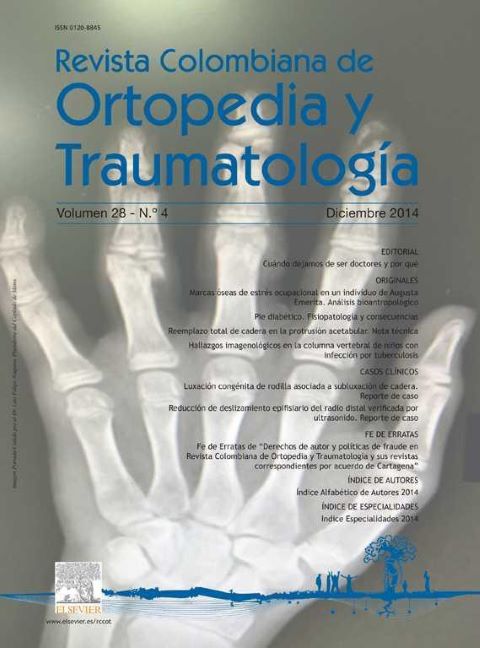Bony landmarks of occupational stress in an individual of Augusta Emerita. Bio-anthropological analysis
DOI:
https://doi.org/10.1016/j.rccot.2015.06.002Keywords:
Augusta Emerita, bio-anthropology, enthesopathy, paleopathology, occupational stressAbstract
Works at the site of Merida, left uncovered remains of several burials: Due to the importance of the discovery, we decided to do the bio-anthropological study of this necropolis south of the city. This article picks up data relating to the study of an interesting case from the perspective of pathological and bio-anthropological studies application fields to the reconstruction of life in the Roman past.
Evidence level IV
Downloads
References
Albert AM, Maples WR. Stages of epiphyseal union for thoracic and lumbar vertebral center as a method of age determination for teenage and young adult skeletons. J Forensic Sci. 1995;40:623-33. https://doi.org/10.1520/JFS13838J
Baxarias J, Herrerín J. The handbook atlas of paleopathology. Zaragoza: Pórtico; 2008.
Baxarias J. La enfermedad en la Hispania romana: estudio de una necrópolis tarraconense. Zaragoza: Pórtico; 2002.
Brothwell DR. Digging up bones. The excavation treatment and study of human skeletal remains. 3 a ed. Ithaca: Cornell University Press; 1981.
Brothwell DR. The relationship of tooth wear to aging. En: MYIscan, editor. Age makers in human skeleton. Springfield, IL: CC. Thomas; 1989. p. 303-16.
Brothwell D. Digging up bones. Nueva York: Cornell University Press; 1986.
Brooks ST, Suchey JM. Skeletal age determination based on the os pubis: A comparison of Acsádo-Nemeskéri and Suchey-Brooks methods. Human evolution. 1990;5:227-38. https://doi.org/10.1007/BF02437238
Buikstra JE, Ubelaker DH. Standard for data collection from human skeletal remains: Proceedings of a seminar at the field Museum of Natural History. Fayetteville: Arkansas Archaeological Survey Press;; 1994.
Capasso L, Pierfelice L, Michetti E, Di Fabrizio A, D'Anastasio R. Lesions linked to althetic activities in the ancient roman population from Herculaneum. Anthropologie. 2004;42:181-7.
Crubézy E. Interactions entre facteurs bio-culturels, pathologie et caractères discrets. Exemple d'une population médiévale: Canac (Aveyron), 417. Montpellier: Université de Montpellier; 1998.
Crubézy E, Goulet J, Buzek J, Jelinek J, Rougé D, Ludes F. Épidémiologie de l'arthrose et des enthésopathies dans une . population européenne d'il y a 7700 ans. Révue du Rhumatisme. 2002;69:1217-25. https://doi.org/10.1016/S1169-8330(02)00443-X
Casas MJ. Principales marcadores óseos macroscópicos de estrés físico en poblaciones humanas: Su validez como indicadores de gestos repetitivos. Universidad Complutense de Madrid; 1997. Tesis doctoral.
Ferembach D. Recommendations for age and sex diagnosis of skeletons. Journal of Human Evolution. 1980;9:517-49. https://doi.org/10.1016/0047-2484(80)90061-5
Ferembach D. Techniques anthropologiques I, craneologie. Ecole Pratique des Hautes Etudes. Paris Lab. d'anthropologie biologique; 1974.
Ferembach D, Schwidettzky I, Stoukal M. Recommendations for age and sex diagnosis of skeletons. J Hum Evol. 1980;9: 517-49. https://doi.org/10.1016/0047-2484(80)90061-5
Fornaciari G, Giuffra V. Lezioni di Paleopatologia. Genova: ICIG; 2009.
Herrmann B, Grupe G, Hummel S, Piepenbrink H, Schutkowski H. Prähistorische Anthropologie. Leitfaden der Feld- und Labormethoden. Springer; 1990. https://doi.org/10.1007/978-3-642-61514-6
Isidro A, Malgosa A. Paleopatología. La enfermedad no escrita. Barcelona: Masson; 2003.
Márquez J. Restos arqueológicos exhumados en un solar de la zona conocida como Los Bodegones Murcianos. Memoria de Mérida. 2000;6:57-78.
Masset C. Age estimation on the basis of cranial sutures. In: MYIscan, (eds.) Age markers in the human skeleton. Springfield, IL: C.C. Thomas, 1989;71-103.
Mendoça MC. Estimation of height from the length of long bones in a Portuguese adult population. Am J Phys Anthropol. 2000;112:39-48. https://doi.org/br86df
Pearson K. On the reconstruction of the stature of prehistoric races. Philosophical transactions of the Royal Society. 1898;192:169-244. https://doi.org/10.1098/rsta.1899.0004
Pearson K. A study ofthe long bones ofthe English skeleton I:the femur. University of London. University College, Department of Applied Statistics, Company Research, Memoris, Biometric Series X, chapters 1-4, 1917-19.
Pearson K. Mathematical contributions to the theory of evolution: on the reconstruction of the stature of prehistoric races. London: Philosophical transactions of the Royal Society; 1899. p. 192. https://doi.org/10.1098/rsta.1899.0004
Slaus M, Pećina-Slaus N, Brkić H. Life stress on the Roman limes in continental Croatia. Homo. 2004;54:240-63. https://doi.org/10.1078/0018-442X-00072
Suchey JM, Katz D. Application of pubic age determination in a forensic setting. Forensic osteology. Advances in identification of human remains. Springfield, IL: CC Thomas; 1998. p. 204-36.
Vallois HD. Anthropometric techniques. Curr Anthropol. 1965;6:127-43. https://doi.org/10.1086/200577
Downloads
Published
How to Cite
Issue
Section
License
Copyright (c) 2024 Revista Colombiana de ortopedia y traumatología

This work is licensed under a Creative Commons Attribution 3.0 Unported License.




